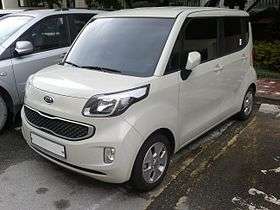Kia Ray
- For the concept car, see Kia Ray (concept car)
| Kia Ray | |
|---|---|
 | |
| Overview | |
| Manufacturer | Kia Motors |
| Production | 2012–present |
| Model years | 2013–present |
| Assembly | Seosan Plant, Seosan, South Korea (Donghee) |
| Body and chassis | |
| Class | City car (A) |
| Body style | 5-door hatchback |
| Layout | FF layout |
| Related | Kia Picanto |
| Powertrain | |
| Engine |
1.0 L Kappa II I3 (petrol) 1.0 L Kappa II I3 (petrol/LPG) |
| Electric motor | 50 kW (67 hp) |
| Battery | 16.4 kWh lithium ion battery |
| Range | 138 km (86 mi) |
The Kia Ray EV is an electric-powered city car manufactured by Kia Motors. The initial roll out was a limited production of 2,500 units destined for the South Korean government fleets, scheduled to be deployed in 2012. The Ray EV is a predecessor to an all-electric crossover SUV that Kia Motors planned to launch globally in 2014.[1] In May 2013 a fleet of 184 Kia Ray EVs were deployed in Seoul as part of a carsharing service called "Electric Vehicle Sharing” at a rate of US$5 per hour. The service has 15,000 registered customers.[2]
The Ray has a unique door layout; the passenger side of the vehicle has a sliding door for the rear seats, while the driver's side has a swing-out door. The car has boxy dimensions, much like other similarly sized cars, such as the Honda Freed and Suzuki Solio. The Ray's interior benefits from the square shape, as it has more space than most cars its size; however, it is only able to seat four people.
The Ray EV is the automaker's first production battery electric vehicle. It is powered by a 50 kW (67 hp) electric motor, with a 16.4 kWh lithium ion battery that allows an all-electric range of 138 km (86 mi) depending on driving conditions.[3]
The Kia Ray is also available in non-EV types equipped with gasoline and bi-fuel with a gasoline and liquefied petroleum gas (LPG) combination. Both engines are available in four trims - Deluxe, Special, Luxury and Prestige. Only available in the local Korea domestic market, both engines produce similar power and outputs. The gasoline engine generates 78ps/6,400rpm and 9.6 kg.m/3,500rpm. Both engines have displacements of 998cc, generating fuel economies of 17 km/l for gasoline, and bi-fuel delivering 16.6 km/l on gasoline mode and 13.2 km/l on LPG mode. Gasoline engine models weigh in at 998 kg with bi-fuel models weighing in at 1,042 kg. Both are equipped with a 4 speed automatic transmission, and are currently sold in the Republic of Korea.
Gallery
See also
- Kia Ray
- Kia Soul EV
- Government incentives for plug-in electric vehicles
- List of electric cars currently available
- List of production battery electric vehicles
- List of modern production plug-in electric vehicles
References
- ↑ "Kia Introduces Ray EV, We Offer Initial Impressions". Car & Driver. Retrieved 2011-12-22.
- ↑ Eric Loveday (2013-05-06). "South Korea Now Offers Electric Vehicle Rentals With Rollout of 184 Kia Ray EVs". InsideEVs.com. Retrieved 2013-06-07.
- ↑ "New Kia Ray is Korea's first production EV". Autoblog Green. 2011-12-22. Retrieved 2012-01-06.
| Kia Motors, a division of Hyundai Motor Group, automobile timeline, 1970s–present | ||||||||||||||||||||||||||||||||||||||||||||||||
|---|---|---|---|---|---|---|---|---|---|---|---|---|---|---|---|---|---|---|---|---|---|---|---|---|---|---|---|---|---|---|---|---|---|---|---|---|---|---|---|---|---|---|---|---|---|---|---|---|
| Type | 1970s | 1980s | 1990s | 2000s | 2010s | |||||||||||||||||||||||||||||||||||||||||||
| 0 | 1 | 2 | 3 | 4 | 5 | 6 | 7 | 8 | 9 | 0 | 1 | 2 | 3 | 4 | 5 | 6 | 7 | 8 | 9 | 0 | 1 | 2 | 3 | 4 | 5 | 6 | 7 | 8 | 9 | 0 | 1 | 2 | 3 | 4 | 5 | 6 | 7 | 8 | 9 | 0 | 1 | 2 | 3 | 4 | 5 | 6 | 7 | |
| City car | Visto | Picanto | Picanto | |||||||||||||||||||||||||||||||||||||||||||||
| Ray | ||||||||||||||||||||||||||||||||||||||||||||||||
| Subcompact car | Brisa | Pride | Qianlima | |||||||||||||||||||||||||||||||||||||||||||||
| Brisa II / K303 | Avella | Rio | Rio | Rio | ||||||||||||||||||||||||||||||||||||||||||||
| Compact car | 124 | Capital | cee'd | cee'd | ||||||||||||||||||||||||||||||||||||||||||||
| Sephia | Sephia | Cerato | Forte | Forte | ||||||||||||||||||||||||||||||||||||||||||||
| Mid-size car | Concord | Credos | Optima | Optima | Optima | Optima | ||||||||||||||||||||||||||||||||||||||||||
| Full-size car | 132 | Enterprise | Opirus | Cadenza | Cadenza | |||||||||||||||||||||||||||||||||||||||||||
| 604 | Potentia | Quoris | ||||||||||||||||||||||||||||||||||||||||||||||
| Sports car | Elan | |||||||||||||||||||||||||||||||||||||||||||||||
| Compact SUV | Sportage | Sportage | Sportage | Sportage | ||||||||||||||||||||||||||||||||||||||||||||
| Retona | ||||||||||||||||||||||||||||||||||||||||||||||||
| Mid-size SUV | Sorento | Sorento | Sorento | |||||||||||||||||||||||||||||||||||||||||||||
| Mohave | ||||||||||||||||||||||||||||||||||||||||||||||||
| Mini MPV | Venga | |||||||||||||||||||||||||||||||||||||||||||||||
| Compact MPV | Joice | Soul | Soul | |||||||||||||||||||||||||||||||||||||||||||||
| Carens | Carens | Carens | Carens | |||||||||||||||||||||||||||||||||||||||||||||
| Large MPV | Carnival | Carnival | Carnival | |||||||||||||||||||||||||||||||||||||||||||||
| Pickup truck | Bongo | Wide Bongo | Bongo Frontier | Bongo | ||||||||||||||||||||||||||||||||||||||||||||
| Minivan | Besta | Pregio | ||||||||||||||||||||||||||||||||||||||||||||||
| Bus | Combi | |||||||||||||||||||||||||||||||||||||||||||||||
| Granbird | Granbird | |||||||||||||||||||||||||||||||||||||||||||||||
| Wikimedia Commons has media related to Kia Ray. |
